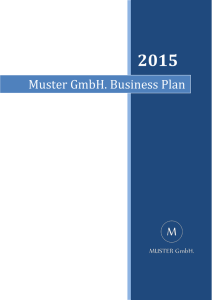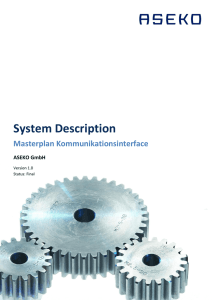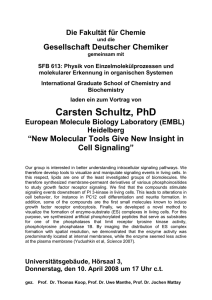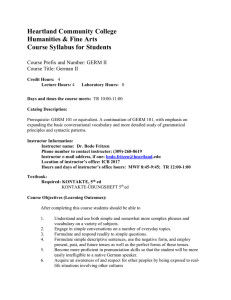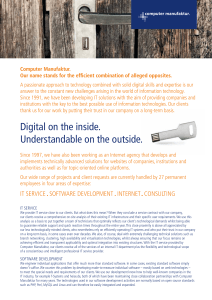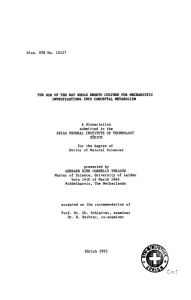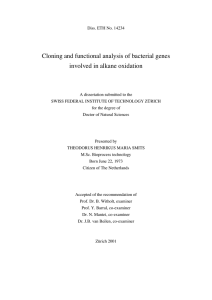Topic 2
Werbung
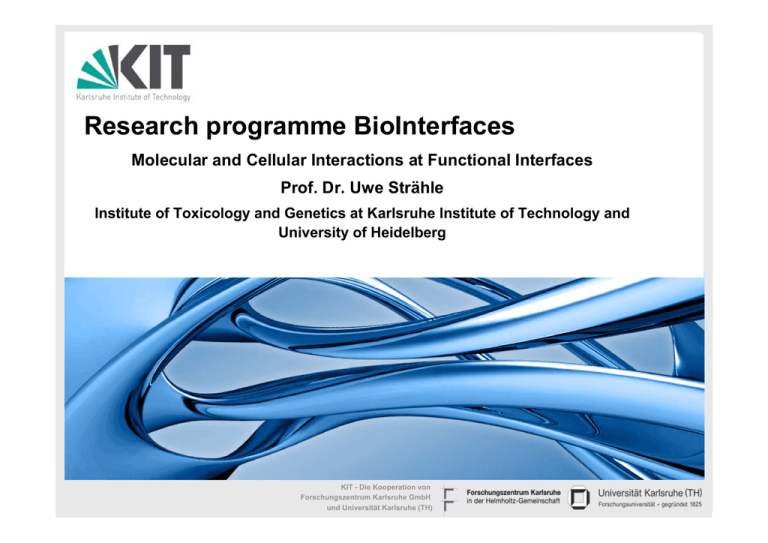
Research programme BioInterfaces Molecular and Cellular Interactions at Functional Interfaces Prof. Dr. Uwe Strähle Institute of Toxicology and Genetics at Karlsruhe Institute of Technology and University of Heidelberg KIT - Die Kooperation von Forschungszentrum Karlsruhe GmbH und Universität Karlsruhe (TH) Scientific Challenges - degenerative diseases - decrease in the rate of drug discovery We require new approaches and tools to tackle these challenges. 2 | Hannover Messe – AIST Delegation, Japan KIT - Die Kooperation von Forschungszentrum Karlsruhe GmbH und Universität Karlsruhe (TH) The complexity of living systems presents enormous technical challenges 1. The scale of the undertaking: - Global understanding of gene function and regulation - Quantitative analysis of biological processes in real time 2. The methods to manipulate living systems - Tailor-made tools (smart drugs) and surfaces 3. The methods to analyse living systems - Analytical instruments (throughput, sensitivity etc) - Sensors - Data storage, processing and information retrieval 3 | Hannover Messe – AIST Delegation, Japan KIT - Die Kooperation von Forschungszentrum Karlsruhe GmbH und Universität Karlsruhe (TH) Selforganization and Repair 4 | Hannover Messe – AIST Delegation, Japan KIT - Die Kooperation von Forschungszentrum Karlsruhe GmbH und Universität Karlsruhe (TH) Cells are the fundamental building blocks of living systems and the basis of development and repair Stem cell in a niche Precursor cell Differentiated cell Embryonic and adult stem cells. Cancer stem cells. Architecture of the niche, growth factors. Cell proliferation, differentiation, migration. 5 | Hannover Messe – AIST Delegation, Japan KIT - Die Kooperation von Forschungszentrum Karlsruhe GmbH und Universität Karlsruhe (TH) Communication of cells with other cells and the environment From Neg et al Science, 2002 6 | Hannover Messe – AIST Delegation, Japan KIT - Die Kooperation von Forschungszentrum Karlsruhe GmbH und Universität Karlsruhe (TH) Global analysis of protein (gene) interaction and function After Tucker, Gera & Uetz (2001) TCB 11: 102 7 | Hannover Messe – AIST Delegation, Japan KIT - Die Kooperation von Forschungszentrum Karlsruhe GmbH und Universität Karlsruhe (TH) BIO Interfaces Part1: The BioInterfaces Programme 8 | Hannover Messe – AIST Delegation, Japan KIT - Die Kooperation von Forschungszentrum Karlsruhe GmbH und Universität Karlsruhe (TH) BioInterfaces: An interdisciplinary program Molecular and cell biology, developmental biology, genetics, systems biology, chemical biology, synthetic biology, chemistry, physics, informatics, mathematics, engineering 9 institutes, 61 research groups, more than 250 workers, three institutions Several companies including Leica and Olympus 9 | Hannover Messe – AIST Delegation, Japan KIT - Die Kooperation von Forschungszentrum Karlsruhe GmbH und Universität Karlsruhe (TH) BioInterfaces An interface is “a point where two systems, subjects, organisations etc meet and interact” Oxford English Dictionary Cells are the fundamental building blocks of living systems. Cells are controlled: - at the interface to the environment (micrometer scale) - by interfaces between molecules (nanometer scale) By manipulating these interfaces we will be able to control cells and living systems 10 | Hannover Messe – AIST Delegation, Japan KIT - Die Kooperation von Forschungszentrum Karlsruhe GmbH und Universität Karlsruhe (TH) Topic 1: Biological Key Targets Aim: Identification and characterization of key targets and processes that control cell proliferation and differentiation - Molecular genetic studies of key processes controlling cells during development and regeneration of the nervous system, eye and muscle and in cancer stem cells - global and genome-wide studies - bioactivity of synthetic nanostructure (incl. toxicity) König et al., Cell, 2008 Uetz et al., Science, 2006 Etard et al., Nature Neuroscience, 2002 Dickmeis et al. PlosBiol. 2007 Jin et al., Nature, 2006 Rembold et al., Science 2006 11 | Hannover Messe – AIST Delegation, Japan KIT - Die Kooperation von Forschungszentrum Karlsruhe GmbH und Universität Karlsruhe (TH) From the CD44v6/c-Met signalosome complex..... ....to a peptide that blocks metastases formation. . ctrl pept v6 pept Orian-Rousseau et al., Genes&Dev, 2002 Matzke et al., Cancer Research, 2005 Orian-Rousseau et al., MBC, 2007 Orian-Rousseau et al., MCB, 2007 Multiple Lung metastases 12 | Hannover Messe – AIST Delegation, Japan KIT - Die Kooperation von Forschungszentrum Karlsruhe GmbH und Universität Karlsruhe (TH) No metastases Topic 2: Synthetic Biomimetic Tools Aim: Rational design and synthesis of bioactive synthetic molecules to control cell behavior Challenges: Targeting of specific cells Targeting of subcellular compartments Synthesis of multifunctional biomimetic entities Cell Balaban et al., PNAS 2002 Schmitz et al., JACS 2007 Schröder et al., J Med Chem 2008 13 | Hannover Messe – AIST Delegation, Japan KIT - Die Kooperation von Forschungszentrum Karlsruhe GmbH und Universität Karlsruhe (TH) Topic 2: Synthetic Biomimetic Tools Structure analysis for the rational design of bioactive synthetic molecules -Structure of key targets and synthetic devices -membrane structure Nano Biology -dynamics of conformational changes in protein-protein, protein-membrane interactions NMR UV-CD Fourier transform infrared spectroscopy Cryoelectron microscopy Modeling of membrane and protein structure POEM (Protein optimization with energy method) Synchrotron Radiation Source ANKA 14 | Hannover Messe – AIST Delegation, Japan KIT - Die Kooperation von Forschungszentrum Karlsruhe GmbH und Universität Karlsruhe (TH) B18 FP23 TAT K3 PGLa/Mag2 PGLa Gramicidin-A Gramicidin-S (CF3)2-PhA Witter et al., JACS 2008 Wadhwani et al., Biopolymers 2007 Tremouilhac et al.. JBC 2006 Glaser et al, Biophysical Jourmal 2005 15 | Hannover Messe – AIST Delegation, Japan KIT - Die Kooperation von Forschungszentrum Karlsruhe GmbH und Universität Karlsruhe (TH) MAP Magainin-2 E5 Alamethicin Topic 3: Biofunctional surfaces Aim: Design and production of artificial cell environments to control and understand cell behavior Challenges -design and synthesis of biocompatible, micro- and nanopatterned substrates - substrates with different elasticity, 3D geometry etc of natural environments - mimicry of growth factors and their distribution - bioreactor design e.g. direct laser writing of photonic crystals Paul et al., Biophysical Journal, 2008 Sabass et al., Biophysical Journal, 2008 Kurz et al., JACS 2008 Giselbrecht et al., Biomedical Microdevices, 2006 von Philipsborn et al., Development 2006 von Philipsborn et al., Nature Protocols 2005 16 | Hannover Messe – AIST Delegation, Japan KIT - Die Kooperation von Forschungszentrum Karlsruhe GmbH und Universität Karlsruhe (TH) Topic 4: Biofilms and antifouling Aim: Design and production of surfaces that permit the control of biofilms. Challenges - identify surface principles that control interaction. of biofilm forming organisms with surfaces. - uncouple stress response from biofilm formation. - identify peptides with antimicrobial properties. Mechanical properties elasticity durability Morphology Structure Hydration Roughness Biocidal activity Chemistry Jungfer et al., Water Research 2007 Hilpert et al., Nature Protocols 2007 Hilpert et al., Nature Protocols 2007 Romani et al., Microb Ecol 2008 Acidity Charge Polarity 17 | Hannover Messe – AIST Delegation, Japan KIT - Die Kooperation von Forschungszentrum Karlsruhe GmbH und Universität Karlsruhe (TH) BIO Interfaces Part 2: Alternative animal models 18 | Hannover Messe – AIST Delegation, Japan KIT - Die Kooperation von Forschungszentrum Karlsruhe GmbH und Universität Karlsruhe (TH) Fish embryos as alternative animal models -to study the molecular control of cell behavior -for drug discovery Developmental neurobiology of the zebrafish - for toxicology. Uwe Strähle, DR2, CNRS Zebrafish - small (3 to 5 cm) fresh water fish -cheap maintenance in large numbers in laboratory environment 19 | Hannover Messe – AIST Delegation, Japan KIT - Die Kooperation von Forschungszentrum Karlsruhe GmbH und Universität Karlsruhe (TH) Why are these fish models so attractive? - transparent embryos and larvae - rapid development outside of mother - many embryos from single spawning - allow forward genetics - vertebrates like human beings Strähle et al. Curr Biol 1994, Müller at al. Bioessays 2002 20 | Hannover Messe – AIST Delegation, Japan KIT - Die Kooperation von Forschungszentrum Karlsruhe GmbH und Universität Karlsruhe (TH) Systemsbiology of vertebrate development Keller et al., Science 2008 21 | Hannover Messe – AIST Delegation, Japan KIT - Die Kooperation von Forschungszentrum Karlsruhe GmbH und Universität Karlsruhe (TH) Fish models for drug discovery - many zebrafish and medaka mutants and transgenic lines represent models for human diseases: polycystic kidney disease, cancer, myopathies, heart defects, addiction, neural and retinal degeneration, infectious diseases etc. - haematochromatosis type 4 caused by mutations in iron transporter ferroportin These can serve as models for drug discovery: -suppressor screens for new drug targets -compound screens to identify leads 22 | Hannover Messe – AIST Delegation, Japan KIT - Die Kooperation von Forschungszentrum Karlsruhe GmbH und Universität Karlsruhe (TH) BIO Interfaces Part 3: Toxicology 23 | Hannover Messe – AIST Delegation, Japan KIT - Die Kooperation von Forschungszentrum Karlsruhe GmbH und Universität Karlsruhe (TH) Toxicology -zebrafish embryo test (DarT) is ecotoxicological standard assay to -assess water quality in Germany. -fish embryos cheap and ethically acceptable -alternatives to mammalian embryos -toxicity testing of early life stages Developmental neurobiology of the zebrafish Why is a substance or nano-composite toxic? Uwe Strähle, DR2, CNRS 24 | Hannover Messe – AIST Delegation, Japan The REACH initiative requires the testing of ten thousands of compounds. KIT - Die Kooperation von Forschungszentrum Karlsruhe GmbH und Universität Karlsruhe (TH) Chemicals induce specific transcriptional signatures Towards a toxicogenomic bar code. Procedure: Expose embryos from 96 to 120 hours post-fertilisation Extract RNA Microarray analysis Yang et al., Genome Biology 2007 25 | Hannover Messe – AIST Delegation, Japan KIT - Die Kooperation von Forschungszentrum Karlsruhe GmbH und Universität Karlsruhe (TH) 14 out of 15 predictions were correct 26 | Hannover Messe – AIST Delegation, Japan KIT - Die Kooperation von Forschungszentrum Karlsruhe GmbH und Universität Karlsruhe (TH) High-throughput screens A screen of 40000 transgenic embryos Müller, Liebel and Reischl in collaboration with Olympus Courtesy of Müller, Liebel, Reischl 27 | Hannover Messe – AIST Delegation, Japan KIT - Die Kooperation von Forschungszentrum Karlsruhe GmbH und Universität Karlsruhe (TH) Automated image processing and analysis Markus Reischl IAI 28 | Hannover Messe – AIST Delegation, Japan KIT - Die Kooperation von Forschungszentrum Karlsruhe GmbH und Universität Karlsruhe (TH) Nanotoxicology Morphology Nanoparticles ? oxidative stress ROS ? Effectors rel. abundance (in %) Size kinases (e.g SAPK), transcription factors (e.g.Nrf2, NF-kB, AP-1) ? median: 52 nm Response inflammatory genes, cytotoxicity... modified from Nel et al., Science, 2006 diameter (in m) 29 | Hannover Messe – AIST Delegation, Japan KIT - Die Kooperation von Forschungszentrum Karlsruhe GmbH und Universität Karlsruhe (TH) Experimental in vitro systems Lung epithelial cells Macrophages Co-culture lung epithelial cells + macrophages Particles to be tested: In vitro submerged • TiO2, SiO2,Fe2O3 • Primary particle size: 10 – 50 nm (500 nm) • Aggregates vs. single particle • Surface properties: hydrophilic vs. lipophilic Cytotoxicity / survival ROS production Signaling anti-oxidant and inflammatory response 30 | Hannover Messe – AIST Delegation, Japan KIT - Die Kooperation von Forschungszentrum Karlsruhe GmbH und Universität Karlsruhe (TH) In vitro Air-liquid interface Karlsruhe Aerosol Exposure Module Aerosol Out Aerosol In Transwell insert Medium Lung cell culture Transwell Insert with cells Medium Mühlhopt et al. 2007 Diabate et al 2002 31 | Hannover Messe – AIST Delegation, Japan KIT - Die Kooperation von Forschungszentrum Karlsruhe GmbH und Universität Karlsruhe (TH) Water 37°C Cells are viable after exposure at the air-liquid interface 110 Viability [% of control] 100 90 lab air filtered air fly ash aerosol 80 70 60 0 1 2 4 Exposure time [h] 6 Dose: 3 – 4 x 104 particles/cm ( 620 g/m) Deposition of particles: 20 ng/cm*h 32 | Hannover Messe – AIST Delegation, Japan KIT - Die Kooperation von Forschungszentrum Karlsruhe GmbH und Universität Karlsruhe (TH) Effects of fly ash after exposure at the air-liquid-interface 1 Lab air 2 Filtered air 3 Fly ash aerosol 1 2 3 1 2 3 1 2 Heme oxygenase-1 3 HO-1 PCNA 2h 4h 6h filtered air fly ash aerosol 1,6 1,4 1,2 IL-8 [ng/ml] anti-oxidative response IL-8 release 1,0 pro-inflammatory response 0,8 0,6 0,4 0,2 0,0 1 2 4 6 Exposure time [h] 33 | Hannover Messe – AIST Delegation, Japan KIT - Die Kooperation von Forschungszentrum Karlsruhe GmbH und Universität Karlsruhe (TH) Mülhopt et al., 2007 Toxicology Platform oxidative stress -Analysis of selected pathways and involvement of ROS -Development of zebrafish embryos as model to study toxicity of nanodevices Effectors -Increase the throughput of the Karlsruhe Aerosol Exposure system Response 34 | Hannover Messe – AIST Delegation, Japan Ph.D. thesis, Susanne Fritsch KIT - Die Kooperation von Forschungszentrum Karlsruhe GmbH und Universität Karlsruhe (TH) Training in the BioInterfaces programme Undergraduate Postgraduate Postdoctoral collaborators Junior group leaders Visiting scientists and students are welcome. Platforms and facilities are open to outside users. Work language is English. 35 | Hannover Messe – AIST Delegation, Japan KIT - Die Kooperation von Forschungszentrum Karlsruhe GmbH und Universität Karlsruhe (TH) BIO Interfaces Thank you 36 | Hannover Messe – AIST Delegation, Japan KIT - Die Kooperation von Forschungszentrum Karlsruhe GmbH und Universität Karlsruhe (TH)
